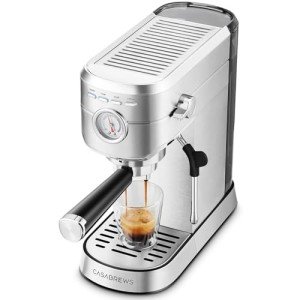Heat Exchange Espresso Machines: A Comprehensive Guide
Espresso machines have evolved substantially throughout the years, accommodating the needs of home baristas and coffee experts alike. Among these machines, heat exchange espresso machines have gotten appeal due to their ability to deliver consistent performance and exceptional brew quality. In this short article, we will explore the functions, benefits, and crucial functions of heat exchange espresso machines, offering a detailed understanding for both possible purchasers and coffee lovers.
Comprehending Heat Exchange Technology
Heat exchange espresso machines operate on a distinct principle that permits synchronised water heating for brewing and steaming. They are geared up with a single boiler that makes use of a heat exchanger system. This feature is significant as it enables users to brew espresso while steaming milk concurrently, promoting efficiency in the coffee-making procedure.
How Does a Heat Exchange Espresso Machine Work?
The process starts with the machine's water inlet filling the boiler. As the water warms up, it turns to steam. The innovative heat exchanger uses hot steam to heat additional water in a separate passage created specifically for the brew group. This implies that water can reach the perfect developing temperature without waiting on the boiler to adjust. The crucial actions consist of:
- Water Fill: Water is drawn into the boiler.
- Heating Process: The boiler warms up as water is transformed into steam.
- Heat Exchange: Steam heats water in the heat exchanger tube.
- Developing: Water from the heat exchanger is pushed through coffee grounds, extracting the tastes required for a rich espresso.
This process permits fast temperature changes and improved coffee extraction.
Benefits of Heat Exchange Espresso Machines
Heat exchange espresso machines provide a number of advantages, particularly for those seeking to optimize their coffee experience. Here are some essential advantages:
- Simultaneous Brewing and Steaming: Users can brew espresso while steaming milk, making it ideal for busy cafes and home baristas who value efficiency.
- Temperature level Stability: The boiler's steam pressure helps maintain a steady temperature, which is vital for constant espresso extraction.
- Versatility: The style allows for quick switching between developing and steaming, making it easier to create numerous coffee drinks, from lattes to coffees.
- Easy to use: Models often feature available controls, making it feasible for both newbies and knowledgeable baristas to produce quality beverages.
- Professional Quality: Heat exchange machines are frequently utilized in commercial settings, supplying users with high-quality developing efficiency in your home.
Key Features to Look for in Heat Exchange Espresso Machines
When considering the purchase of a heat exchange espresso machine, there are several functions that one must take into consideration:
- Build Quality: Look for machines made from durable products, such as stainless steel or brass, guaranteeing longevity.
- Boiler Size: A larger boiler will hold more water and sustain greater output gradually.
- PID Temperature Control: This feature assists maintain consistent brew temperatures, which can enhance the coffee-making procedure.
- Group Head Design: Machines with a saturated or semi-saturated group head offer better temperature stability.
- Relieve of Use: User-friendly user interfaces and intuitive controls improve the total experience for baristas at all ability levels.
- Steam Wand Quality: A great steam wand with appropriate insulation and flexibility permits much better texturing of milk.
- Water Reservoir Size: Depending on your requirements, consider how frequently you wish to fill up the water reservoir.
Comparison of Popular Heat Exchange Espresso Machines
To much better comprehend the options offered in the market, listed below is a contrast table of some popular heat exchange espresso machines:
| Machine Model | Boiler Size | PID Control | Price Range | User Ratings |
|---|---|---|---|---|
| Profitec Pro 700 | 2.0 L | Yes | ₤ 2,000-₤ 2,500 | 9.5/ 10 |
| Rocket Espresso R58 | 1.8 L | Yes | ₤ 2,400-₤ 2,800 | 9.4/ 10 |
| Elekta Bianca | 1.8 L | Yes | ₤ 2,500-₤ 3,000 | 9.6/ 10 |
| La Spaziale S1 Vivaldi II | 1.5 L | Yes | ₤ 1,800-₤ 2,200 | 9.2/ 10 |
| Bezzera Magica | 1.2 L | No | ₤ 1,600-₤ 1,800 | 9.0/ 10 |
FAQs About Heat Exchange Espresso Machines
What is the main difference between a heat exchange and a dual boiler espresso machine?
While both types can brew espresso and steam milk at the same time, dual boiler machines have separate boilers for developing and steaming. On the other hand, heat exchange machines make use of a single boiler and a heat exchanger to attain the same function.
Are heat exchange machines ideal for newbies?
Yes! Lots of heat exchange machines are created with easy to use features, making them available for newbies. With proper guidance and practice, users can rapidly produce quality espresso.
What sort of maintenance do heat exchange espresso machines require?
Routine maintenance includes descaling, cleaning up the boiler, inspecting seals and gaskets, and keeping the group head clean. Regular upkeep guarantees longevity and consistent efficiency.
Can I use a heat exchange machine for various kinds of coffee beverages?
Absolutely! Learn Alot more enable users to produce a range of coffee beverages, consisting of espresso, lattes, cappuccinos, and more.
Heat exchange espresso machines represent a mix of development and tradition, providing coffee enthusiasts with the tools required for crafting the ideal cup. Their ability to all at once brew and steam, combined with precise temperature level control, makes them an engaging option for both home baristas and experts. With the ideal understanding on functions and upkeep, users can unlock a world of elegant coffee experiences, guaranteeing that each sip is as wonderful as the last.

